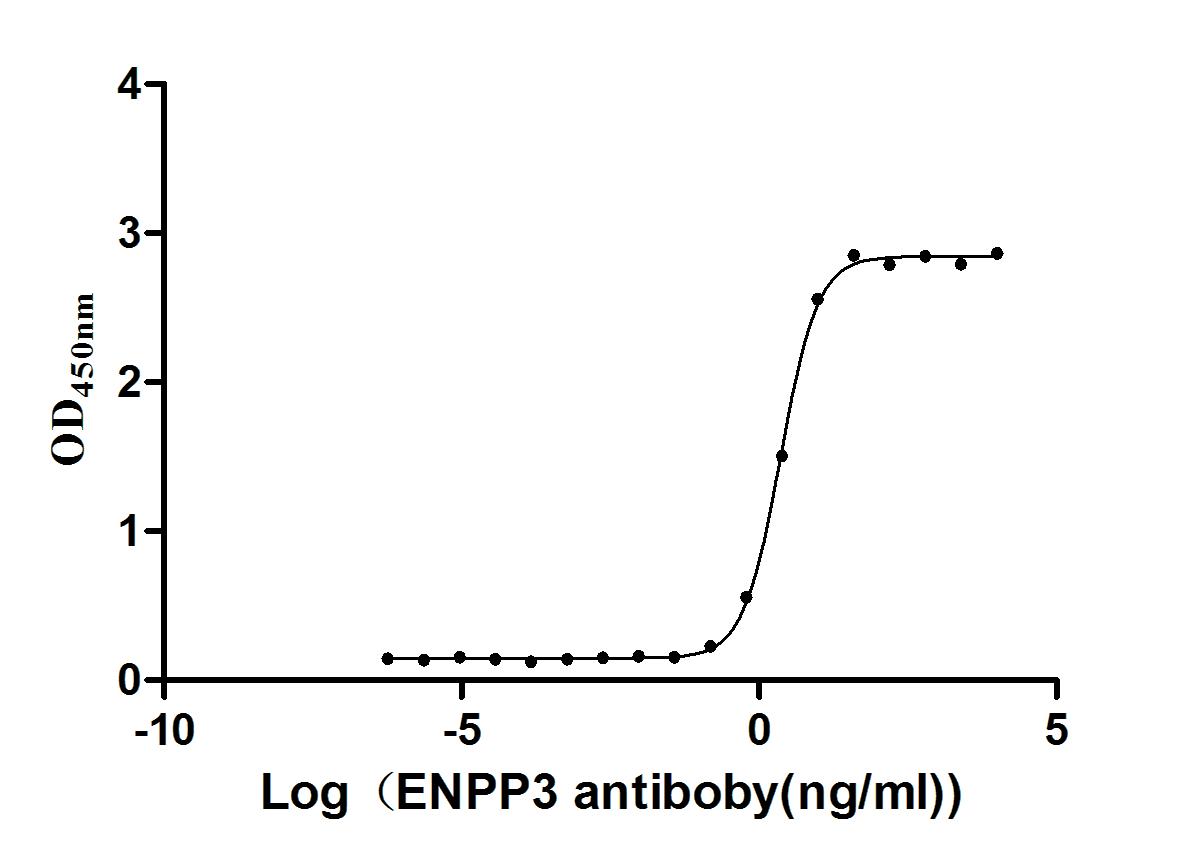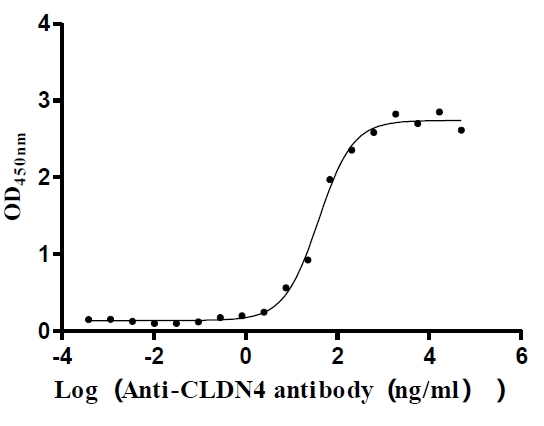Recombinant Human C-X-C motif chemokine 13 protein (CXCL13), partial
-
中文名稱:Recombinant Human C-X-C motif chemokine 13 protein(CXCL13),partial
-
貨號(hào):CSB-EP006243HU1
-
規(guī)格:¥1344
-
圖片:
-
其他:
產(chǎn)品詳情
-
純度:Greater than 90% as determined by SDS-PAGE.
-
基因名:
-
Uniprot No.:
-
別名:ANGIE; ANGIE2 ; B cell attracting chemokine 1; B cell-attracting chemokine 1; B lymphocyte chemoattractant; B-cell chemoattractant ; B-cell-attracting chemokine 1; B-cell-homing chemokine (ligand for Burkitt's lymphoma receptor-1); BCA-1; BLC; BLR1L ; C-X-C motif chemokine 13; Chemokine (C-X-C motif) ligand 13 ; Chemokine (C-X-C motif) ligand 13 (B-cell chemoattractant) ; Chemokine; CXC motif; ligand 13; CXC chemokine BLC; CXCL13; CXL13_HUMAN; SCYB13; Small inducible cytokine B subfamily (Cys-X-Cys motif); member 13 (B-cell chemoattractant); Small inducible cytokine B13; Small inducible cytokine subfamily B; member 13; Small-inducible cytokine B13
-
種屬:Homo sapiens (Human)
-
蛋白長(zhǎng)度:Partial
-
來源:E.coli
-
分子量:12.8kDa
-
表達(dá)區(qū)域:23-95aa
-
氨基酸序列VLEVYYTSLRCRCVQESSVFIPRRFIDRIQILPRGNGCPRKEIIVWKKNKSIVCVDPQAEWIQRMMEVLRKRS
Note: The complete sequence including tag sequence, target protein sequence and linker sequence could be provided upon request. -
蛋白標(biāo)簽:N-terminal 6xHis-tagged
-
產(chǎn)品提供形式:Liquid or Lyophilized powder
Note: We will preferentially ship the format that we have in stock, however, if you have any special requirement for the format, please remark your requirement when placing the order, we will prepare according to your demand. -
緩沖液:Tris-based buffer,50% glycerol
-
儲(chǔ)存條件:Store at -20°C/-80°C upon receipt, aliquoting is necessary for mutiple use. Avoid repeated freeze-thaw cycles.
-
保質(zhì)期:The shelf life is related to many factors, storage state, buffer ingredients, storage temperature and the stability of the protein itself.
Generally, the shelf life of liquid form is 6 months at -20°C/-80°C. The shelf life of lyophilized form is 12 months at -20°C/-80°C. -
貨期:Basically, we can dispatch the products out in 1-3 working days after receiving your orders. Delivery time may differ from different purchasing way or location, please kindly consult your local distributors for specific delivery time.Note: All of our proteins are default shipped with normal blue ice packs, if you request to ship with dry ice, please communicate with us in advance and extra fees will be charged.
-
注意事項(xiàng):Repeated freezing and thawing is not recommended. Store working aliquots at 4°C for up to one week.
-
Datasheet & COA:Please contact us to get it.
相關(guān)產(chǎn)品
靶點(diǎn)詳情
-
功能:Chemotactic for B-lymphocytes but not for T-lymphocytes, monocytes and neutrophils. Does not induce calcium release in B-lymphocytes. Binds to BLR1/CXCR5.
-
基因功能參考文獻(xiàn):
- CXCL13 is elevated in cerebrospinal fluid in children with Lyme neuroborreliosis. PMID: 30083887
- We found a strong association of CXCL13 rs355689*C allele with essential hypertension under additive (OR 0.56, PFDR = 0.008) and dominant (OR 0.41, PFDR 4.38 x 10- 4) genetic model. Our results indicate that CXCL13 rs355689 polymorphism is strongly associated with essential hypertension in the ethnic group of Tatars from Russia. PMID: 30019153
- High CXCL13 expression was associated with larger tumor diameter and shorter OS. By multivariate analysis, CXCL13 expression was associated with OS independently from clinicopathological factors. PMID: 29085997
- IL-17 enhances the migration of B cells during asthma by inducing CXCL13 chemokine production in structural lung cells. PMID: 27639935
- the findings of the present study indicated that the noninvasive investigation of urinary CXCL13/Cr may be valuable for the detection of AR, particularly antibodymediated rejection . In addition, high urinary CXCL13/Cr levels predicted a poor response to steroid treatment and compromised graft function PMID: 29956754
- CXCL13 seems to be a useful marker of disease activity in systemic lupus erythematosus, but not in cutaneous lupus erythematosus or chronic cutaneous lupus erythematosus. PMID: 29728857
- Serum level of CXCL13 is associated with disease activity in systemic lupus erythematosus but does not seem to be a biomarker for arthritis. PMID: 29338586
- Serum CXCL13 positivity was found to be associated with oral symptoms, ocular signs and hyperglobulinemia in Asian Indian patients with primary Sjogren's syndrome. PMID: 29541901
- we found that CXCL13 indeed has a high sensitivity and specificity for diagnosing LNB, which means that it can be used as a new diagnostic biomarker for the diagnosis of LNB. PMID: 28972436
- the elevated concentrations of CXCL13, CXCL8, and CXCL10 or their increasing CSF/serum ratios may be potential biomarkers of neurosyphilis PMID: 27650493
- CXCL13 is a highly sensitive and specific CSF marker that helps to differentiate Lyme neuroborreliosis from other central nervous system disorders in children. PMID: 28859668
- Study suggested that maternal rs355687 variant in CXCL13 gene was associated with decreased risk of HBV intrauterine infection compared to those with CC genotypes. PMID: 27212637
- Elevations in serum MDC and BLC were independently associated with the significant risk of early stage lung adenocarcinoma, even in non-smokers and in stage IA patients. PMID: 27811371
- Studied CSF levels of B-lymphocyte Chemoattractant CXCL13 in children with Lyme neuroborreliosis (LNB), and found CSF CXCL13 levels were substantially higher in children with LNB compared with children with other diagnoses. PMID: 28661964
- This study indicated that CXCL13 may be pathogenically involved in Clostridium difficile infection (CDI) and served as a potential new biomarker for diagnosis and prognosis in CDI. PMID: 27685937
- This study indicated that CXCL13 rather than IL-31 may have clinical values of diagnosis and prognosis in hepatocellular carcinoma. PMID: 27663978
- CXCL13/CXCR5 mediated the aggregation of B cells, that directed the aberrant humoral immune responses via the formation of ectopic germinal centers, which suggests a molecular mechanism of neurological damage in neurosyphilis. PMID: 28931218
- High CXCL13 expression is associated with B-cell Lymphoma. PMID: 28108506
- CCL21 and CXCL13 levels are increased in the minor salivary glands of patients with Sjogren's syndrome. PMID: 27782867
- we demonstrate that PKCepsilon cooperates with the loss of the tumor suppressor Pten for the development of prostate cancer in a mouse model. Mechanistic analysis revealed that PKCe overexpression and Pten loss individually and synergistically upregulate the production of the chemokine CXCL13, which involves the transcriptional activation of the CXCL13 gene PMID: 28402859
- During remission, serum CXCL13 and BAFF levels have not decreased to normal in neuromyelitis optica patients, and B-cell-related autoimmune response persists. Immunosuppressive therapy decreased serum BAFF levels, but did not affect CXCL13 expression. PMID: 28413701
- This study suggested that increased serum levels of CXCL13 might be involved in renal ectopic lymphoid tissue (ELT)formation and renal impairment process in lupus nephritis. PMID: 27990444
- CXCL13 mRNA expression and protein levels were significantly up-regulated in the brain from temporal lobe epilepsy patients. PMID: 27873133
- CXCL13 could be a potential biomarker for predicting recurrence in HBV-related hepatocellular carcinoma patients after hepatectomy. PMID: 26517519
- was overexpressed in pulmonary vascular lesions of patients with IPAH and CTEPH, and increased serum concentrations were found in patients with IPAH and CTEPH, suggesting a potential pathogenic role of CXCL13 in both diseases. PMID: 26927848
- Findings suggest the potential use of chemokine CXCL13 as a plasma biomarker of germinal centers (GCs) activity in vaccine trials and other clinical settings. PMID: 26908875
- Aqueous humor concentration of CXCL13 is correlated with subfoveal choroidal thickness in normal subjects. PMID: 26121407
- Serum CXCL10 and CXCL13 levels may serve as clinical markers and contribute to the inflammatory response, especially skin manifestations thereof, in adult-onset Still's disease PMID: 26385705
- findings reveal a neuronal/astrocytic interaction in the spinal cord by which neuronally produced CXCL13 activates astrocytes via CXCR5 to facilitate neuropathic pain. PMID: 26752644
- Gene encoding CXCL13 was identified as being upregulated and found to be negatively correlated with survival over 3-year follow-up period in Idiopathic pulmonary fibrosis. PMID: 26109466
- Therefore, CSF CXCL13 concentrations could improve the diagnosis of ANS in HIV-infected patients PMID: 25769888
- In the presence of endometriosis, proliferative-phase endometrial expression of CXCL13 markedly increased. PMID: 25031316
- CXCL13 and CCL4 could act as circulating biomarkers in autoimmune hemolytic anemia (AIHA), and higher plasma soluble TNFRII might favor the diagnosis of SLE-related instead of primary AIHA. PMID: 25889297
- This is the first to indicate the clinical relevance of CXCL13 to young breast cancer and represents a potential therapeutic target for young breast cancer. PMID: 25990390
- Findings demonstrate a link between CXCL13 and primary Sjogren's syndrome disease activity and lymphoma. PMID: 26359802
- CXCL13 plays an important role in the progression of hepatocellular carcinoma. PMID: 26161394
- a direct target of IRF5 resulting in the enhanced recruitment of B and T cells to IRF5-positive tumor-conditioned media PMID: 25533286
- CXCL13 might predict survival outcomes in patients with extranodal natural killer (NK)/T-cell lymphoma PMID: 25966773
- our findings suggest that CXCL13-CXCR5 axis promotes the growth, migration, and invasion of colon cancer cells, probably via PI3K/AKT pathway PMID: 25476740
- CXCL13 up-regulation may be differently linked to the development of primary central nervous system lymphomas and to the accumulation of tumor-infiltrated lymphocytes. PMID: 25433721
- marked elevations of serum CXCL13 levels resided nearly completely within the seropositive population of rheumatoid arthritis patients PMID: 24766912
- In primary biliary cirrhosis, CXCL13 promotes aggregation of CD19(+) B cells and CXCR5(+) CD4(+) T cells. PMID: 25627620
- CSF CXCL13 levels correlated with CSF cell count, total protein, IgG Index and with the presence of CSF IgG and IgM oligoclonal bands. PMID: 26004159
- Data indicate that patients with high baseline plasma C-X-C motif chemokine 13 (CXCL13) levels had an improved chance of remission after 2 years. PMID: 25249397
- After validation in larger patient groups, CXCR5 and CXCL13 may prove useful as biomarkers for nonsmall cell lung carcinoma Correspondingly, blockade of this axis could serve as an effective therapy for nonsmall cell lung carcinoma. PMID: 25271023
- Data show that chemokine CXCL13 production by monocytes required toll-like receptor 7 activation and secretion of interferon-alpha. PMID: 25667414
- Myofibroblast activation and CXCL13 expression also occur in the normal prostate after androgen deprivation, and CXCL13 is expressed by myofibroblasts in human prostate cancer. PMID: 25267627
- The study confirms the relevance of CXCL13 as a diagnostic biomarker of neuroborreliosis and suggests that CSF CXCL13 in NB is linked to duration of disease PMID: 19965843
- overexpressed in myasthenia gravis thymus PMID: 24393484
- highly significant stepwise progressive increase in CXCL 13 level was recorded through controls, inactive SLE and active disease (P < 0.01). Moreover, it correlated positively with SLEDAI and proteinuria (P < 0.01). PMID: 25812350
顯示更多
收起更多
-
亞細(xì)胞定位:Secreted.
-
蛋白家族:Intercrine alpha (chemokine CxC) family
-
組織特異性:Highest levels in liver, followed by spleen, lymph node, appendix and stomach. Low levels in salivary gland, mammary gland and fetal spleen.
-
數(shù)據(jù)庫鏈接:
Most popular with customers
-
Recombinant Human Macrophage migration inhibitory factor (MIF) (Active)
Express system: Mammalian cell
Species: Homo sapiens (Human)
-
Recombinant Human Cannabinoid receptor 1 (CNR1)-VLPs (Active)
Express system: Mammalian cell
Species: Homo sapiens (Human)
-
Express system: Mammalian cell
Species: Homo sapiens (Human)
-
Recombinant Human Claudin-4 (CLDN4)-VLPs (Active)
Express system: Mammalian cell
Species: Homo sapiens (Human)
-
Recombinant Human CD81 antigen (CD81), partial (Active)
Express system: Mammalian cell
Species: Homo sapiens (Human)
-
Recombinant Human Carcinoembryonic antigen-related cell adhesion molecule 8(CEACAM8) (Active)
Express system: Mammalian cell
Species: Homo sapiens (Human)
-
Express system: Mammalian cell
Species: Homo sapiens (Human)




















